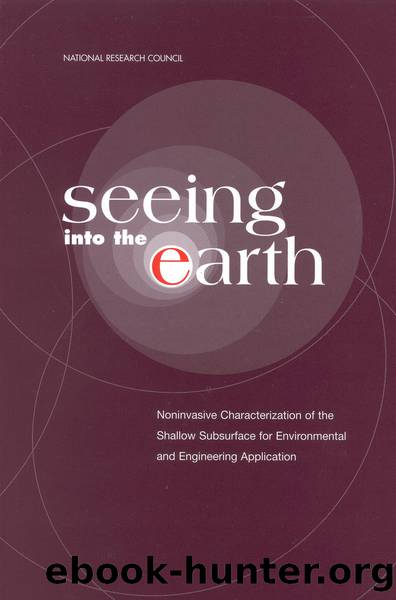seeing into the earth: Noninvasive Characterization of the Shallow Subsurface for Environmental and Engineering Applications by National Research Council

Author:National Research Council
Language: eng
Format: epub
Tags: Earth Sciences
Publisher: NATIONAL ACADEMY PRESS
Published: 2000-04-30T00:00:00+00:00
GROUND PENETRATING RADAR
GPR is similar to the seismic reflection method in the basic wave propagation physics, but uses high-frequency electromagnetic waves in the tens of megahertz to gigahertz range. Details of the acquisition process differ markedly from the seismic method, most notably because only one channel is acquired. The contrasts being measured with GPR are differences in dielectric permittivity across earth boundaries. The dielectric permittivity is a measure of the ability of a material to store electrical charge (like a capacitor or battery) and principally determines the velocity of propagation of the electromagnetic wave. The product of the dielectric permittivity and the magnetic permeability is analogous to seismic impedance. The real part of this product (complex modulus) usually describes how the material stores energy and the imaginary part describes how the material loses (or dissipates) energy.
The EM wave propagates in the earth at the speed of light divided by the square root of the dielectric constant of the geological material. The depth of investigation is inversely proportional to the near-surface conductivity of soils and pore fluids. Due to the smaller wavelengths used in the GPR method, resolution is commonly as much as one order of magnitude better than current seismic reflection techniques.
The quality of GPR data and its usefulness in site characterization are determined by (1) the electrical properties of the site, (2) the equipment used, (3) data acquisition procedures and parameters, (4) data processing, and (5) methodologies for interpretation and visualization. The greatest limitation to the widespread use of GPR is the electrical conductivity at a site, which determines the depth of penetration. As a rough guide, GPR is considered to be most useful when the conductivity is less than 10 mS/m (Davis and Annan, 1989); this generally prevents effective applications of GPR in clay-rich environments.
Download
This site does not store any files on its server. We only index and link to content provided by other sites. Please contact the content providers to delete copyright contents if any and email us, we'll remove relevant links or contents immediately.
Whiskies Galore by Ian Buxton(41880)
Introduction to Aircraft Design (Cambridge Aerospace Series) by John P. Fielding(33064)
Rewire Your Anxious Brain by Catherine M. Pittman(18553)
Craft Beer for the Homebrewer by Michael Agnew(18140)
Cat's cradle by Kurt Vonnegut(15186)
Sapiens: A Brief History of Humankind by Yuval Noah Harari(14252)
Leonardo da Vinci by Walter Isaacson(13184)
The Tidewater Tales by John Barth(12608)
Thinking, Fast and Slow by Kahneman Daniel(12079)
Underground: A Human History of the Worlds Beneath Our Feet by Will Hunt(12024)
The Radium Girls by Kate Moore(11921)
The Art of Thinking Clearly by Rolf Dobelli(10223)
A Journey Through Charms and Defence Against the Dark Arts (Harry Potter: A Journey Throughâ¦) by Pottermore Publishing(9232)
Mindhunter: Inside the FBI's Elite Serial Crime Unit by John E. Douglas & Mark Olshaker(9201)
Tools of Titans by Timothy Ferriss(8218)
Wonder by R. J. Palacio(8010)
Turbulence by E. J. Noyes(7936)
Change Your Questions, Change Your Life by Marilee Adams(7635)
Nudge - Improving Decisions about Health, Wealth, and Happiness by Thaler Sunstein(7615)
